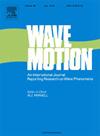Numerical investigations of deep learning-assisted delamination characterization using ultrasonic guided waves
IF 2.5
3区 物理与天体物理
Q2 ACOUSTICS
引用次数: 0
Abstract
Ultrasonic guided waves have been applied extensively for nondestructively detecting delamination in multilayered structures. However, traditional guided-wave-based nondestructive evaluation (NDE) techniques require highly skilled users to interpret the complex wave field scattered by the delamination. To overcome this challenge, this study proposes an approach that combines a deep-learning (DL) neural network with traditional ultrasonic NDE techniques. The NDE technique used here is based on guided waves generated and received in a transmitter-receiver configuration. A 2D finite element analysis (FEA) model is constructed to simulate the guided wave interactions with a delamination between two metallic layers, which yields both the training and testing data. The tailored DL neural network is a convolutional neural network (CNN) combined with bi-directional long short-term memory (BiLSTM). This hybrid neural network is trained by a set of pulse-echo or pitch-catch time-domain data. Once trained, the DL neural network predicts the location of delamination using the recorded pulse-echo time-domain signals as input, and the length of delamination using the recoded pitch-catch time-domain as input. This process of nondestructively characterizing the location and size of delamination can be carried out automatically without the need to analyze the complex wave fields in the ultrasonic tests. The predicted results on both within-range and out-of-range unseen data demonstrate that the proposed technique has tremendous potential for characterizing delamination in practical NDE and structural health monitoring (SHM) applications.
超声导波深度学习辅助分层表征的数值研究
超声导波在多层结构的分层无损检测中有着广泛的应用。然而,传统的基于导波的无损评估(NDE)技术需要高技能的用户来解释由分层散射的复杂波场。为了克服这一挑战,本研究提出了一种将深度学习(DL)神经网络与传统超声波NDE技术相结合的方法。这里使用的无损检测技术是基于在发射器-接收器配置中产生和接收的导波。建立了二维有限元分析(FEA)模型,模拟了两金属层间分层时导波的相互作用,得到了训练和测试数据。量身定制的DL神经网络是卷积神经网络(CNN)与双向长短期记忆(BiLSTM)相结合。这种混合神经网络是由一组脉冲回波或音高捕捉时域数据来训练的。经过训练后,深度学习神经网络使用记录的脉冲回波时域信号作为输入来预测分层的位置,并使用重新编码的音调捕捉时域作为输入来预测分层的长度。这种无损表征分层位置和尺寸的过程可以自动进行,而不需要在超声检测中分析复杂的波场。对范围内和范围外未见数据的预测结果表明,所提出的技术在实际濒死体验和结构健康监测(SHM)应用中具有巨大的表征分层的潜力。
本文章由计算机程序翻译,如有差异,请以英文原文为准。
求助全文
约1分钟内获得全文
求助全文
来源期刊

Wave Motion
物理-力学
CiteScore
4.10
自引率
8.30%
发文量
118
审稿时长
3 months
期刊介绍:
Wave Motion is devoted to the cross fertilization of ideas, and to stimulating interaction between workers in various research areas in which wave propagation phenomena play a dominant role. The description and analysis of wave propagation phenomena provides a unifying thread connecting diverse areas of engineering and the physical sciences such as acoustics, optics, geophysics, seismology, electromagnetic theory, solid and fluid mechanics.
The journal publishes papers on analytical, numerical and experimental methods. Papers that address fundamentally new topics in wave phenomena or develop wave propagation methods for solving direct and inverse problems are of interest to the journal.
 求助内容:
求助内容: 应助结果提醒方式:
应助结果提醒方式:


